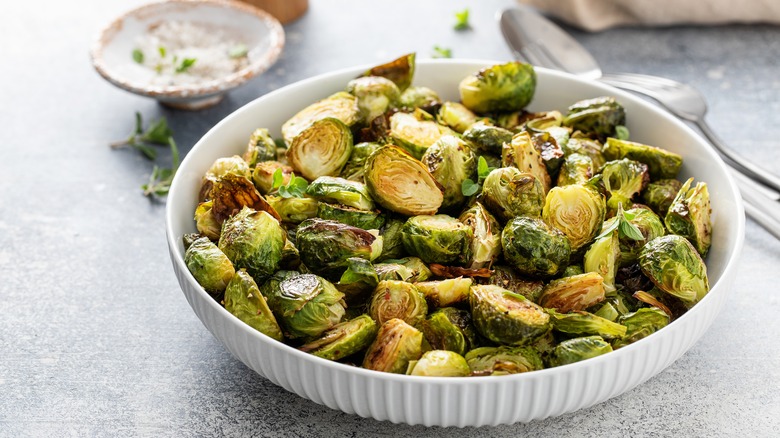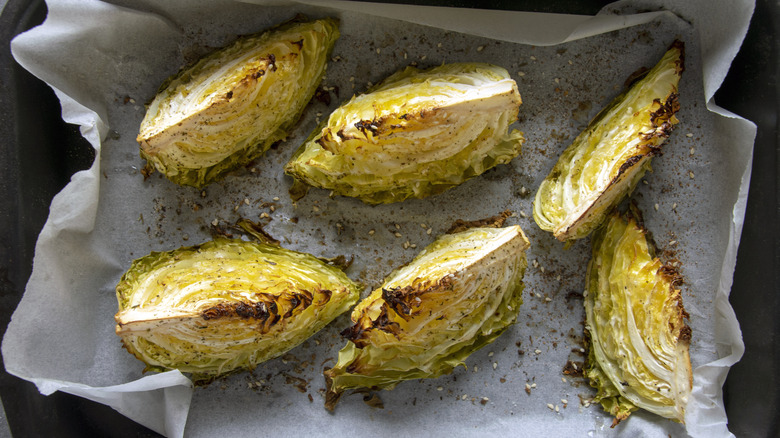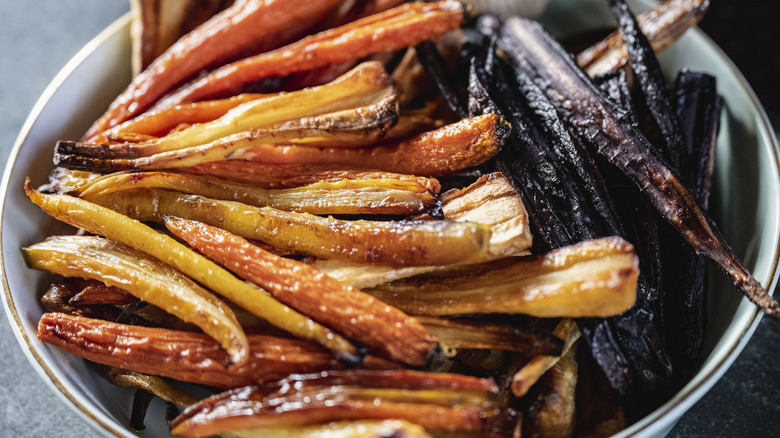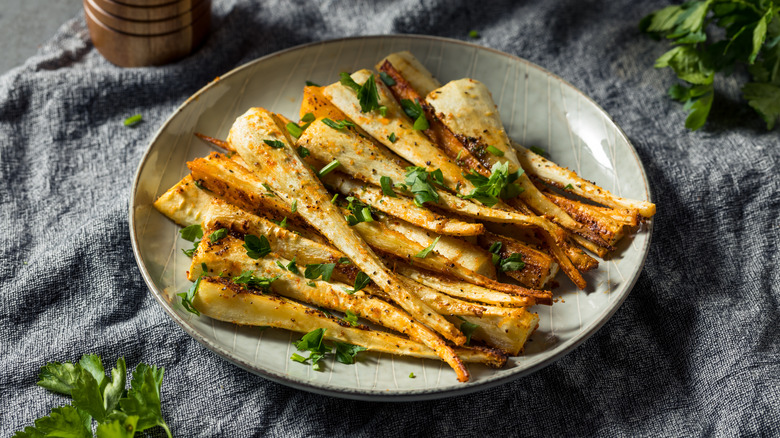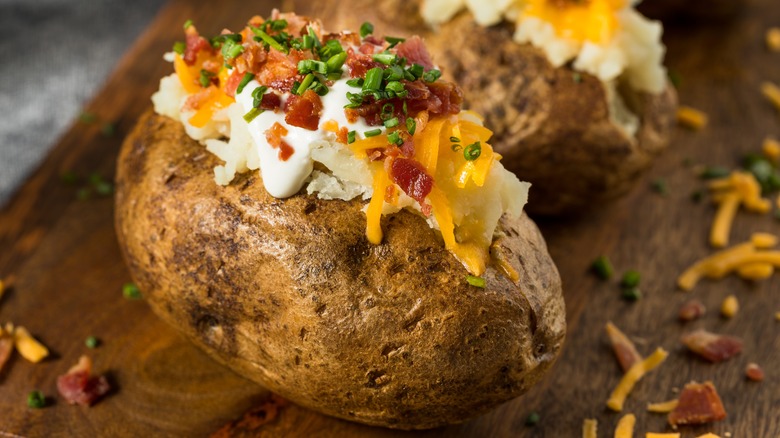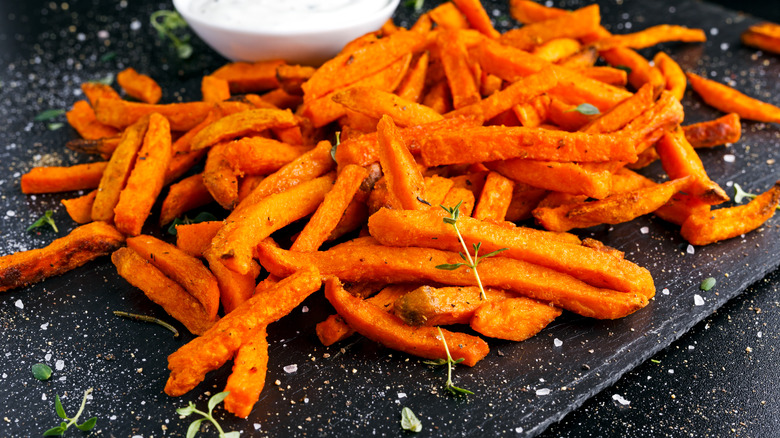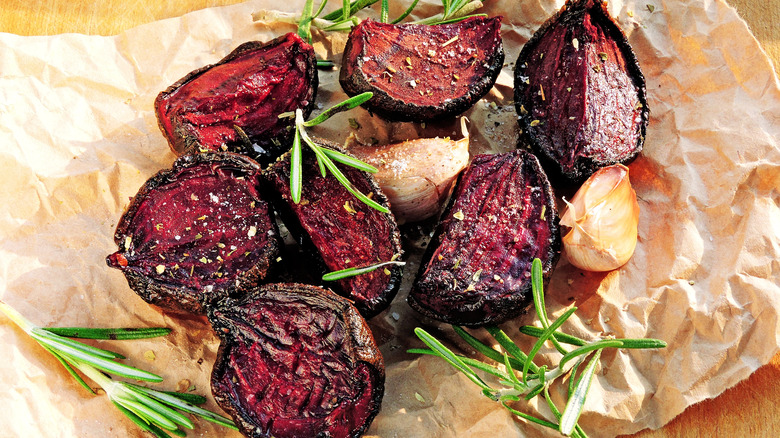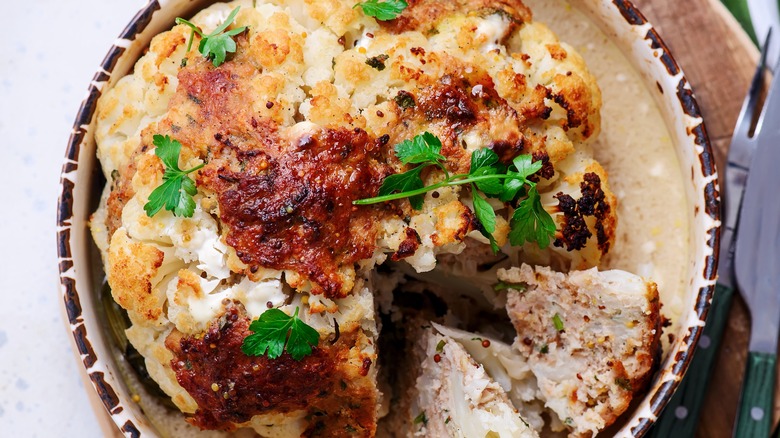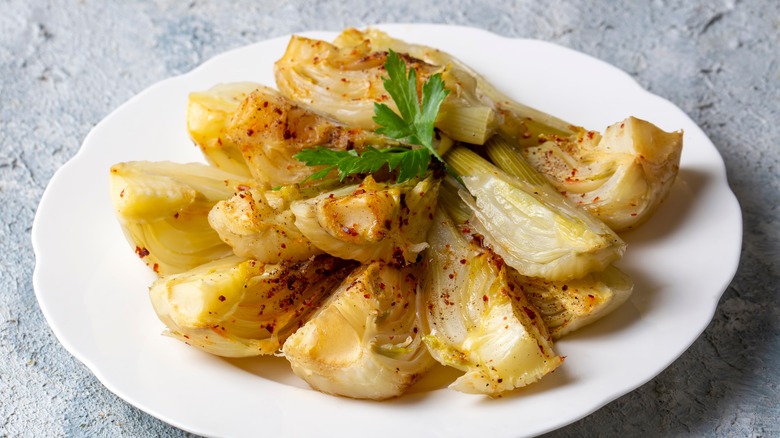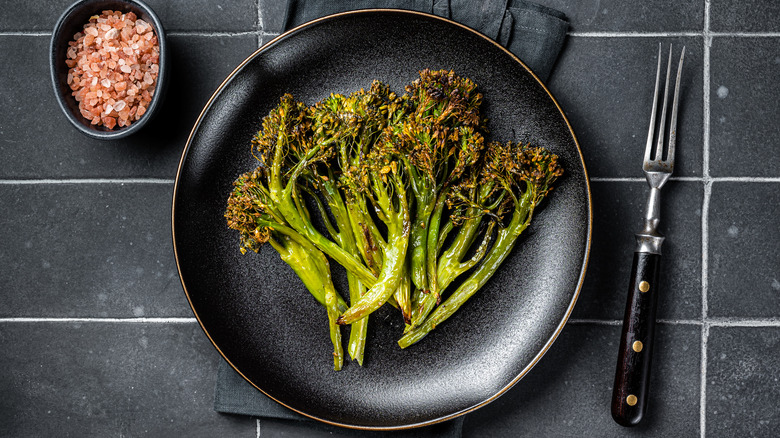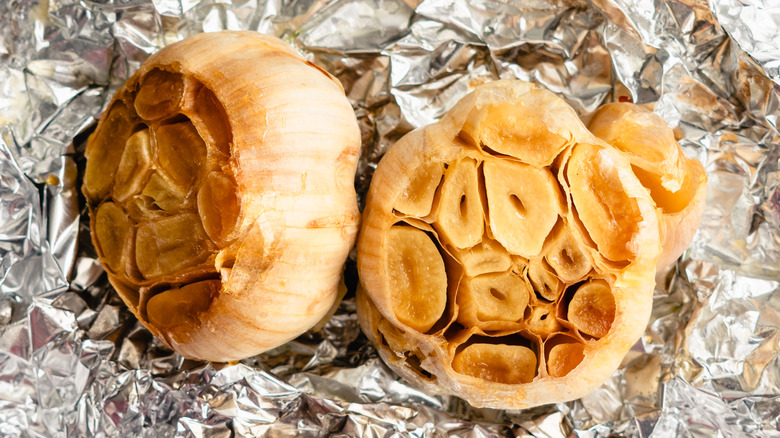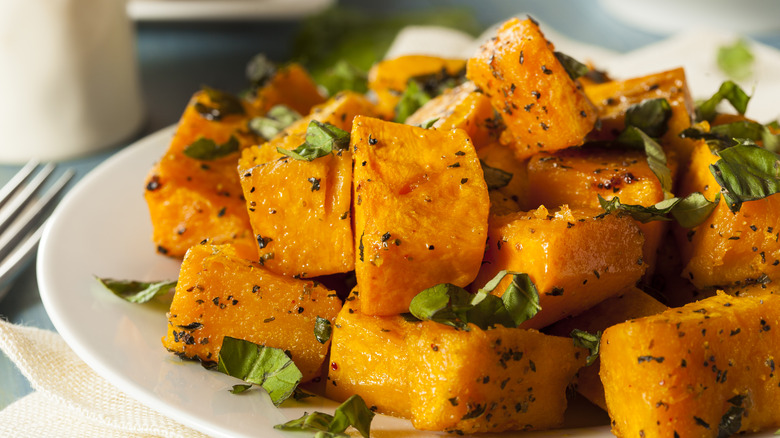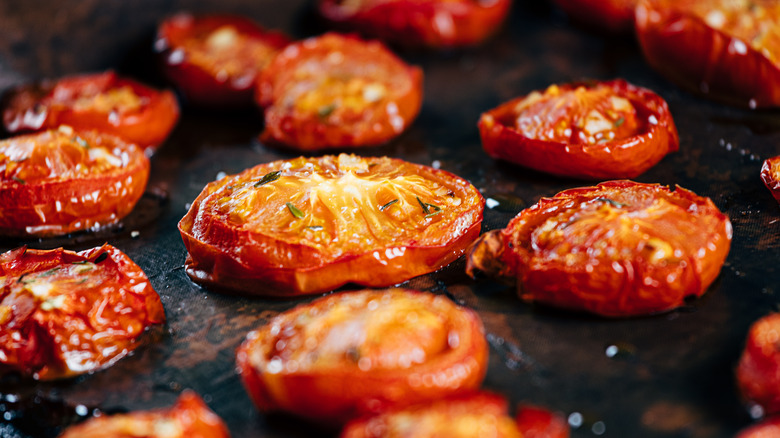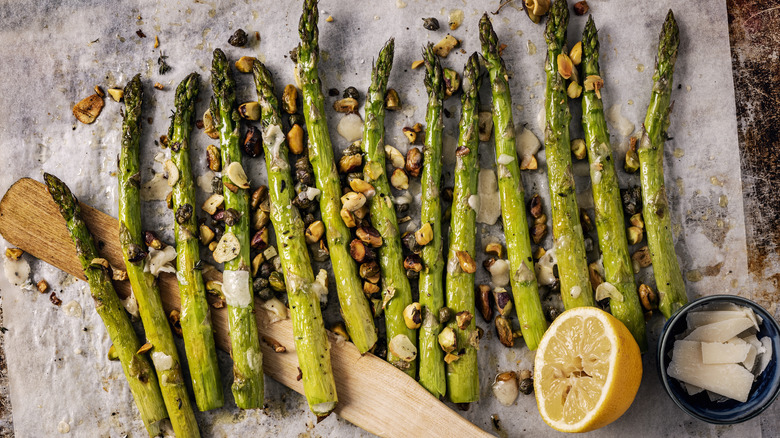14 Best Vegetables To Roast In The Oven
It's safe to say that vegetables have come a long way. While some diners may believe the only option is to suffer through steamed medleys with little seasoning, there are actually numerous ways to make veggies tastier. Now, if you're just discovering the larger world of plant-based cuisine or consider yourself a culinary green thumb, you may be wondering what the best options are for jazzing up vegetables (and unlocking any hidden potential). But of the many cooking methods available, the oven takes the throne for vegetables.
Nothing beats roasted vegetables, like a filling baked potato with a perfectly pillowy center. Admittedly, a baked potato is nothing new, but a twice-baked potato that's loaded with savory toppings? Well, that's an entirely different level of indulgence. Simply put, when you're looking to fire up the oven and sharpen your veggie-making skills, there's no shortage of options at your disposal.
Having led a plant-forward lifestyle for nearly 10 years, I've clocked countless hours preparing vegetables in the oven. Additionally, I was able to expand my skill set while working as a garde manger at Elf Cafe, which has since been listed as a must-try Los Angeles restaurant in the Michelin Guide. Since numerous veggies are simply better when roasted, here's a list of the best vegetables to prepare in the oven.
Brussels sprouts
Brussels sprouts had a bad rep for a long time. In fact, these supposed grassy balls of dirt are the likely reason why so many children remained stuck at the dinner table until they finished their veggies. Of course, one could say the myth that Brussels sprouts aren't delicious has been perpetuated by the prevalence of steaming and boiling the veggie. But ever since oven-roasting entered the culinary zeitgeist, roasted Brussels sprouts have become a delicious staple on menus across the U.S.
Roasting unlocks the true power of Brussels sprouts by overcoming the unappealing, over-soft consistency offered by boiling or steaming. More than that, if you aren't a fan of the veggie's inherently earthy taste, the oven is the way to go. It adds a delectable char, makes the vegetable's flavor profile more palatable, and better infuses seasonings and sauces.
Anyone can whip up this easy balsamic-roasted Brussels sprouts recipe at home, but balsamic only scratches the surface of flavorful possibilities. Cheese lovers will fall head over heels for this crispy Parmesan-crusted Brussels sprouts dish, whereas those who like sweet with their savory must try maple bacon-wrapped balsamic Brussels sprouts. Give one or more of these recipes a try and you'll find that Brussels don't have to be boring.
Cabbage
Cabbage is currently the belle of the vegetable ball. Like Brussels sprouts in the early 2000s, restaurants everywhere are serving cabbage in the 2020s. From kimchi and slaw to wraps (and more), chefs have rediscovered this oft-overlooked veggie — and our tummies are all the better for it. Now, since cabbage is comprised of more than 90% water, it can be somewhat resistant to flavoring, and a challenge to cook. Of course, one of the best ways to extract moisture and reduce the liquid in cabbage is by cooking it in the oven.
Of all the ways to prepare cabbage, roasting is a surefire contender for the throne. It's particularly ideal if you prefer cooked cabbage with bite (and without the raw coleslaw consistency). Plus, roasting gives cabbage a crave-worthy char. Though grilling offers a similar outcome, it can also overpower any other flavors, so roasting offers a better balance.
You're unlikely to ever run out of tasty roasted cabbage recipes, either. Wedge-style roasted cabbage is popular, but I personally enjoy separating it into individual leaves. Wedges are great for a stand-alone side, but leaves are the best bet for topping foods. If you'd like to try both styles, consider preparing this bright, lemon-sauced roasted cabbage dish.
Carrots
The root vegetable category is filled with delicious oven-ready options (and some of the most nutritious veggies around, as well). Carrots, for example, can be life-changing when cooked in the oven. If you haven't tried roasting carrots before, you've been missing out on some serious untapped potential.
For starters, steamed carrots are fairly boring — particularly compared to the joy felt when biting into the wrinkly, charred skin of a roasted carrot with a moist center. Plus, while these orange-colored spears pack a whole lot of sweetness that can quickly overpower dishes, roasting helps to temper them.
Cooking carrots in the oven brings out a creamy flavor, with a caramelization that rounds out the saccharine component. This roasted curry carrots and mint vinaigrette recipe is sweet, savory, and herbaceous, and a great example of how versatile roasted carrots can be. However, if you want something that highlights the veggie's inherent sweetness, I recommend trying a simple honey butter glaze on your carrots.
Parsnips
One root vegetable that's commonly mistaken for a carrot is the parsnip. After all, aside from color, they look largely identical. However, parsnips are fairly different from carrots. They have a distinct texture and taste, and offer differing nutrients, as well. Both are loaded with fiber, but parsnips are particularly rich in vitamins C and K, folate, and antioxidants. Taste-wise, parsnips are sweet, with a spicy, almost cinnamon-like undertone. They have a heartier consistency than carrots, as well, and are just as suited for oven-roasting.
Now, if you've never tried parsnips, the earthy, nutmeg kick can take some getting used to. Once you're ready, there are plenty of surefire parsnip pairings available when preparing the vegetable in the oven. You can get a sweet fix with parsnip crème brûlée or go savory with a sprinkle of Parmesan cheese. The oven makes the consistency creamy and melts the cheese into a crunchy, crispy coat.
Parsnips can be complemented by a number sweet components, as well; think maple syrup or brown sugar glazes, zesty honey balsamic, or brown butter. They work great in refreshing dishes, too, like a kale salad with roasted parsnips and cauliflower. There's simply no better time to explore the possibilities of parsnips in the oven.
Potatoes
Potatoes are among the most beloved root vegetables. Easy to grow, nutritious, and affordable, to say potatoes are versatile would be an understatement. Of course, since people have been brainstorming ways to prepare potatoes for thousands of years, it's difficult to determine which cooking method is superior. Frying is an obvious favorite, of course, but also the least healthy option. The oven, on the other hand, offers a range of potato prep options that are not only healthier, but just as tasty.
Trust me: oven-cooked potatoes aren't your ordinary tubers. After all, something beautiful happens when you slow-cook potatoes. The interior becomes fluffy and soft, like biting into a starchy cloud that can only be reached after you chew through a crunchy layer. I mentioned twice-baked potatoes earlier, but that's merely the tip of the potato-berg (so to speak). Wait until you try a super slow-cooked loaded baked potato. It may take longer to bake, but your stomach will thank you once it's finished.
Roasting is equally fingerling-licking good, and can make fingerling potatoes extra crispy. There are many other ways to add more flavor to roasted potatoes – all you have to do is let your culinary creativity run free.
Sweet potatoes
Sweet potatoes don't enjoy the same spotlight as regular potatoes, but they're arguably just as good. Sweet potatoes come in several varieties, which often have a different appearance, taste, and consistency. There are the moister jewel sweet potatoes, the perfect-for-baking garnet type, as well as the drier, denser purple sweet potato (among others). Of course, no matter the variety, you should cook this root veggie in the oven whenever possible.
From classic sweet potato pie to candied yams, if you've been sleeping on cooking this vegetable in the oven? It's time to wake up. For one thing, baking is better than frying when it comes to making sweet potato fries. Unlike regular potatoes, frying sweet ones tends to toughen the consistency, whereas baking makes the outside crispy while keeping the inside tender (at least, that's been my experience).
Roasted sweet potatoes are just as grub-worthy. The natural flavor is scrumptiously sweet by itself, so salt and seasoning aren't always needed. You can also turn them into a saccharine mash with a caramelized taste or add starchy sweetness to tuna salad. Additionally, while some believe the best temperature to bake sweet potatoes is 425 degrees Fahrenheit, I prefer to bake them at 450 degrees Fahrenheit instead. Simply rub the sweet spud with a bit of oil, poke some holes in it with a fork, wrap it loosely in foil, and toss it into the oven for 75 minutes or so.
Beets
Beets don't always get the love they deserve, perhaps because of their robust earthiness. The veggie's terrestrial taste comes from an organic compound called geosmin, which produces microbes that smell like fresh rain or soil. While this acquired flavor keeps many people from experiencing their culinary glory, there are some beet varieties that taste less grassy than others. If savory soil sounds off-putting, then, the Detroit dark red and Crosby green top varieties are great options and become mouth-watering bites when cooked in the oven.
Straightforward roasting offers the best method for cooking beets in the oven. Like potatoes, beets can be cubed or cooked whole in aluminum foil; in fact, though their consistency is somewhat different to potatoes, many of the same culinary techniques can be used for beets. There are some things to remember, though. For example, I typically remove the skin from beets, but it depends on the recipe when it comes to potato skins.
Charred, sweet, and earthy, roasted beets complement all sorts of dishes. They can work as a filling addition to a refreshing kale and roasted beet salad with feta, as well as when transformed into Mediterranean-style roasted beet falafel. You can also enjoy them solo with an orange-kissed balsamic glaze. Keep in mind that beets leech a vibrant red color into everything they touch — including cookware and other foods. Because of this, one of the best tips for roasting beets is to cook them separately from other foods.
Cauliflower
In my time working at Elf Cafe, one of the tastiest dishes I prepared was a za'atar-seasoned whole roasted cauliflower. Now, somewhat surprisingly, cooking whole cauliflower heads hadn't crossed my mind before that. But when I tasted it for the first time, it was like biting into an explosion of new possibilities. Simply, the oven is far superior to other cauliflower cooking options — and you've been going about it entirely wrong if you've only ever used the stovetop.
Roasting cauliflower always delivers, particularly if you prefer the veggie with some bite. Boiling, for example, will over-soften the vegetable, while negatively impacting the nutrient content, as well. This might be great if you're making creamy mashed cauliflower, but it's less ideal if you want to retain the many nutrients found in cauliflower.
You can keep it simple with roasted cauliflower steaks. Those are really awesome when covered with delicious ground meats or sauteed veggies. You may have tried crispy baked cauliflower wings, as well, which have become a popular appetizer at many restaurants. The best part about this cruciferous vegetable is its versatility. After all, just wait until you try roasted cauliflower "mac" and cheese.
Fennel
Fennel is another vegetable with a distinctive flavor (which you've likely tasted before in sausages). This bulb-shaped veggie has a mild anise, licorice-like profile that stands out — even if only a little is used. It's part of the same family as carrots and is composed of layers like an onion. The taste can be polarizing, but when prepared properly in the oven, it offers exciting flavors.
Let's start with the basics. The first step involves removing the fronds (or the leafy green portion) before cutting it into thin slices. With each fennel slice, you should be able to see the layers. These layers can be separated and added to salads and rice dishes, cooked whole, or cut into wedges. Realistically, it all depends on the recipe.
Those partial to the vegetable's unique flavor will love this simple braised fennel dish. It's also great when paired with savory proteins like salt-baked fish and a crave-worthy roast pork tenderloin with fennel-citrus salad. Of course, there are numerous other mouthwatering options for cooking fennel in the oven, so don't hesitate to explore additional recipes.
Broccolini
Broccolini is like the elevated cousin of broccoli. It looks like broccoli and has a similar texture, but is a totally distinct vegetable. Broccolini is less earthy and more sweet, with a thin stalk of loose florets. Like roasted Brussels sprouts and cauliflower Buffalo "wings," broccolini has become a mainstay on many modern restaurant menus. Whether enjoyed solo or served atop a flavorful dish, broccolini can deliver deliciousness; and though there are numerous surefire cooking methods, consider roasting broccolini before other options.
The fiery confines of the oven can produce the most crave-able broccolini in just 15 minutes at 425 degrees Fahrenheit. Have it as a quick lunchtime snack or an easy dinnertime side. This vegetable has amazing flavor, so it doesn't require much seasoning. A simple drizzle of oil, sprinkle of salt, and a squeeze of lemon will do. At the same time, this vegetable takes well to sauces and other flavored oils when cooked in the oven. A little soy sauce or nutty sesame seed oil will give it a delectable roast, but be sure to avoid overcooking broccolini unless you want soggy-lini.
Garlic
What would cooking be without garlic? When it comes to flavoring, you'd be hard-pressed to find anything that does the job better. Whether fresh cut, powdered, or charred, garlic can elevate countless dishes to new heights. Unsurprisingly, one of the tastiest ways to enjoy garlic is by roasting it whole in the oven.
Now, if you're wondering why you should spend extra time roasting garlic when you can simply purchase it minced from the store, allow me to explain. First, roasting caramelizes garlic, giving it a milder kick, toasted flavor, and creamy butter-like consistency. You can literally squeeze it from the skin like toothpaste to flavor dishes. Furthermore, garlic can be roasted whole while still inside its peel, making it much simpler to prepare than some may imagine.
Since it pairs well with so many recipes, consider using roasted garlic to spruce up sauces or make a savory aioli. You can even prepare a simple oven-roasted garlic with minimal ingredients and prep. Simply slice off the stem (along with the top ¼ of the bulb), wrap it in aluminum foil, and roast for 45 minutes at 375 degrees Fahrenheit.
Butternut squash
There's just something special about orange-colored root vegetables. Whether it's a sweet potato, pumpkin, or butternut squash, deliciousness awaits. Of course, butternut squash might deserve more love than most for how amazing it tastes when cooked in the oven.
Roasting this versatile fall vegetable brings out a ton of flavor. In fact, because butternut squash has a naturally sweet, nutty, and earthy taste, little seasoning is necessary. One low-maintenance recipe that delivers scrumptious results is a spiced baked butternut squash dish. Though you'll need several additional spices and seasonings for this recipe, roasted butternut squash is often just as good with only salt.
Other tasty ways to cook and enjoy this veggie in the oven include a hearty roasted butternut squash salad. Additionally, a butternut squash and bacon quiche recipe is a gateway to foodie heaven. Bacon, eggs, and cheese are a proven trifecta, and when paired with butternut squash, you'll be begging for more.
Tomatoes
This list wouldn't be complete without tomatoes. Besides being quick and easy to roast, they can elevate breakfast, lunch, and dinner. The most obvious (though arguably under-utilized) way to use oven-roasted tomatoes is for homemade tomato sauce. It's so easy to make that there's literally no reason for store-bought pasta sauce. Making a homemade sauce grants more freedom to experiment with different ingredients, as well, like roasted tomatoes, which bring caramelized smokiness for amped-up savoriness.
You can boost your breakfast with roasted tomatoes, too. They add a refreshing zest and toasted char to fried egg sandwiches and omelets, and when cheese is added to the equation? You'll be inspired to roast tomatoes more often. Oven-cooked tomatoes can also cover your lunchtime cravings. If you're a lover of caprese salad, this roasted tomato-topped caprese sandwich is a next level option for summer get-togethers. From classic tomato soup to roasted balsamic bruschetta, good luck finding a more versatile ingredient than roasted tomatoes.
Asparagus
Personally, I feel asparagus exists somewhere between overrated and perfectly ranked. They're undeniably tasty, but the itsy-bitsy amount of flesh can be disappointing. Aside from that nitpicky critique, asparagus can be mouthwatering — and the oven trumps other cooking methods for this veggie.
Now, you have to be careful. After all, asparagus is easy to mess up given it cooks super fast, so it's all about finding the sweet spot. Cook it for too long and the consistency becomes mushy; too quickly and you'll have to contend with inedible fibrous strands. Roasting, then, is the answer to perfectly cooked asparagus. A simple roasted asparagus dish with just olive oil, lemon juice, salt, and pepper provides a delectable side for steaks, mashed potatoes, white-sauce pasta, and seafood.
You can serve roasted asparagus with poultry, as well, like this chicken sausage and asparagus sheet-pan meal. Be sure to purchase thicker asparagus rather than thin ones for most recipes, though. The additional flesh helps reduce the chances of overcooking it, and also gives you more to bite into. I'd also recommend following Julia Child's tip for tender roast asparagus by peeling the stalks before cooking.

